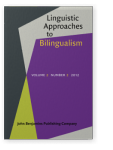Alexiadou, Artemis, Vasiliki Rizou & Foteini Karkaletsou
2023.
Agreement Asymmetries with Adjectives in Heritage Greek.
Languages 8:2
► pp. 139 ff.

Amengual, Mark
2018.
Asymmetrical interlingual influence in the production of Spanish and English laterals as a result of competing activation in bilingual language processing.
Journal of Phonetics 69
► pp. 12 ff.

Amengual, Mark
2019.
Type of early bilingualism and its effect on the acoustic realization of allophonic variants: Early sequential and simultaneous bilinguals.
International Journal of Bilingualism 23:5
► pp. 954 ff.

ARSLAN, SEÇKİN, DÖRTE DE KOK & ROELIEN BASTIAANSE
2017.
Processing grammatical evidentiality and time reference in Turkish heritage and monolingual speakers.
Bilingualism: Language and Cognition 20:3
► pp. 457 ff.

Atlamaz, Ümit, Ömer Demirok & Metin Bağrıaçık
2023.
Heritage grammars as checkpoints in acquisition: A Dependent Case Theoretic account.
Glossa: a journal of general linguistics 8:1

Baten, Kristof & Aaricia Ponnet
Baten, Kristof & Saartje Verbeke
Bhatia, Archna & Silvina Montrul
Bhatia, Archna & Silvina Montrul
Camacho, José
2022.
Paradigmatic Uniformity: Evidence from Heritage Speakers of Spanish.
Languages 7:1
► pp. 14 ff.

CHANG, CHARLES B.
2016.
Bilingual perceptual benefits of experience with a heritage language.
Bilingualism: Language and Cognition 19:4
► pp. 791 ff.

CHONDROGIANNI, Vasiliki & Richard G. SCHWARTZ
2020.
Case marking and word order in Greek heritage children.
Journal of Child Language 47:4
► pp. 766 ff.

Cortiana, Giulia & Yasaman Rafat
2021.
production of L2 Italian voiced palatal lateral and voiced palatal nasal by English-speaking learners.
Journal of Monolingual and Bilingual Speech 3:1

Coskun Kunduz, Aylin & Silvina Montrul
2022.
Sources of variability in the acquisition of Differential Object Marking by Turkish heritage language children in the United States.
Bilingualism: Language and Cognition 25:4
► pp. 603 ff.

Coşkun Kunduz, Aylin & Silvina Montrul
2023.
Input factors in the acquisition of evidentiality by Turkish heritage language children and adults in the United States.
Language Acquisition ► pp. 1 ff.

Dabašinskienė, Ineta & Eglė Krivickaitė-Leišienė
2019.
Lithuanian as L2: A Case Study of Russian Minority Children. In
Multilingualism in the Baltic States,
► pp. 205 ff.

Dehé, Nicole & Tanja Kupisch
2022.
Prepositional phrases and case in North American (heritage) Icelandic.
Nordic Journal of Linguistics 45:3
► pp. 254 ff.

Di Pisa, Grazia, Sergio Miguel Pereira Soares, Jason Rothman & Theodoros Marinis
2024.
Being a heritage speaker matters: the role of markedness in subject-verb person agreement in Italian.
Frontiers in Psychology 15

Fuchs, Zuzanna
2022.
Eyetracking evidence for heritage speakers’ access to abstract syntactic agreement features in real-time processing.
Frontiers in Psychology 13

Karayayla, Tuğba & Monika S. Schmid
2019.
First Language Attrition as a Function of Age at Onset of Bilingualism: First Language Attainment of Turkish–English Bilinguals in the United Kingdom.
Language Learning 69:1
► pp. 106 ff.

Kim, Kitaek, William O’Grady & Bonnie D. Schwartz
Lago, Sol, Martina Gračanin-Yuksek, Duygu Fatma Şafak, Orhan Demir, Bilal Kırkıcı & Claudia Felser
Mardale, Alexandru & Silvina Montrul
Mardale, Alexandru & Silvina Montrul
Montrul, Silvina
2012.
Bilingualism and the Heritage Language Speaker. In
The Handbook of Bilingualism and Multilingualism,
► pp. 168 ff.

Montrul, Silvina
2023.
Heritage Languages: Language Acquired, Language Lost, Language Regained.
Annual Review of Linguistics 9:1
► pp. 399 ff.

Montrul, Silvina & Andrew Armstrong
Montrul, Silvina & Nicoleta Bateman
2020.
Vulnerability and stability of Differential Object Marking in Romanian heritage speakers.
Glossa: a journal of general linguistics 5:1

Montrul, Silvina & Nicoleta Bateman
Montrul, Silvina & Nicoleta Bateman
Montrul, Silvina, Archna Bhatia, Rakesh Bhatt & Vandana Puri
2019.
Case Marking in Hindi as the Weaker Language.
Frontiers in Psychology 10

Montrul, Silvina & Noelia Sánchez-Walker
2013.
Differential Object Marking in Child and Adult Spanish Heritage Speakers.
Language Acquisition 20:2
► pp. 109 ff.

O'Grady, William
2015.
Processing Determinism.
Language Learning 65:1
► pp. 6 ff.

Park, Mi Yung & William O'Grady
2013.
An Interview with William O'Grady, University of Hawai'i at Manoa.
The Korean Language in America 18:1
► pp. 141 ff.

Park, Mi Yung & William O'Grady
2013.
An Interview with William O'Grady, University of Hawai'i at Manoa.
The Korean Language in America 18:1
► pp. 141 ff.

Ponnet, Aaricia, Kristof Baten & Saartje Verbeke
Ponnet, Aaricia & Ludovic De Cuypere
2024.
The acquisition of Hindi split-ergativity and differential object marking by Dutch L1 speakers: systematicity and variation.
Language Acquisition 31:2
► pp. 145 ff.

Putnam, Michael T., Lara Schwarz & Andrew D. Hoffman
2021.
Morphology of Heritage Languages. In
The Cambridge Handbook of Heritage Languages and Linguistics,
► pp. 613 ff.

Sagarra, Nuria, Liliana Sánchez & Aurora Bel
Sendek, Katherine, David P. Corina, Deborah Cates, Matthew J. Traxler & Tamara Y. Swaab
2023.
L1 referential features influence pronoun reading in L2 for deaf, ASL–English bilinguals.
Bilingualism: Language and Cognition 26:4
► pp. 738 ff.

Uygun, Serkan & Claudia Felser
Yager, Lisa, Nora Hellmold, Hyoun-A Joo, Michael T. Putnam, Eleonora Rossi, Catherine Stafford & Joseph Salmons
2015.
New Structural Patterns in Moribund Grammar: Case Marking in Heritage German.
Frontiers in Psychology 6

[no author supplied]
2021.
Grammatical Aspects of Heritage Languages. In
The Cambridge Handbook of Heritage Languages and Linguistics,
► pp. 579 ff.

This list is based on CrossRef data as of 4 june 2024. Please note that it may not be complete. Sources presented here have been supplied by the respective publishers.
Any errors therein should be reported to them.
